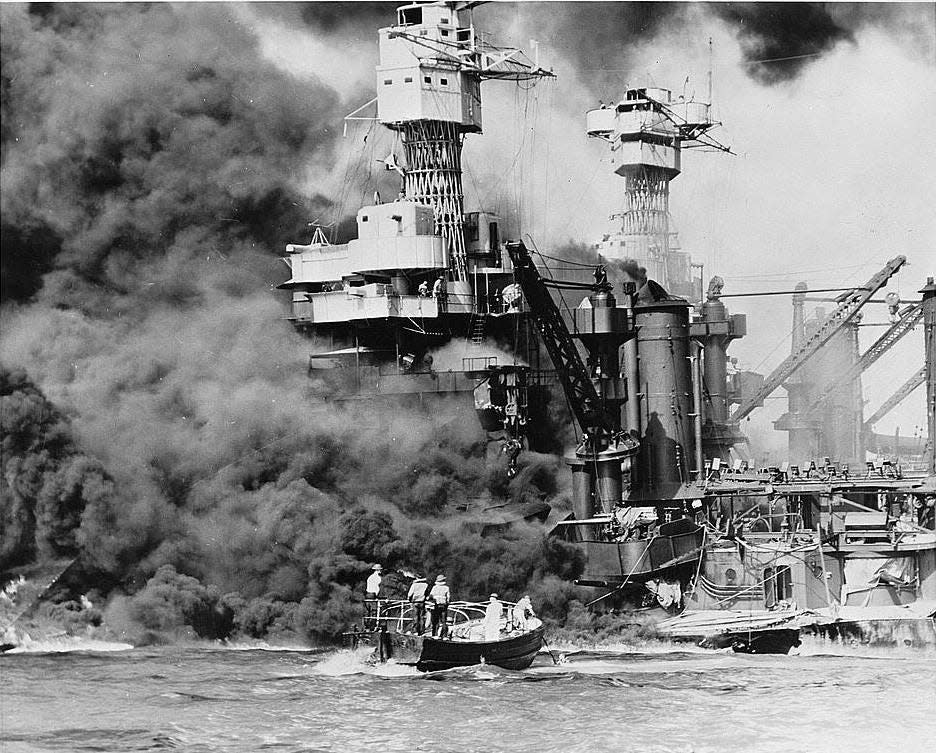Texas History Minute: The Day Which Live in Infamy

It came to be called the Day Which Will Live in Infamy. The attack on the American naval base at Pearl Harbor on December 7, 1941, was a devastating loss for the nation. When the attack began at 7:55 a.m. by Japanese forces, the Americans on the scene realized that their lives in that moment had changed. The American entry into World War II would transform the face of the war and forever alter the course of the nation and of the men and women who fought to protect it.
By December 1941, most of the globe was engulfed in World War II while the United States tried to stay out of it. Nations on five continents were already embroiled in conflict. American military and political leaders somberly noted that the nation would likely be drawn into the fight as well while they watched Allied losses mount. To the last, America tried to avoid war. As the United States continued to negotiate for peace with Japan, Japan plotted a sneak attack.

Japan had unleashed sneak attacks at the beginnings of previous wars. And Japanese military officials hoped that crippling American naval forces while they went on a massive offensive across the Pacific would neutralize American advantages and allow Japan a quick victory.
In ninety minutes on what had been a quiet Sunday morning, the American fleet was wrecked. Four battleships were sunk with the other four crippled. Many other ships and planes were severely damaged. One hundred fifty-nine planes were destroyed. And in the end, 2,403 Americans were killed.
One of the first Americans to spring into action was a Waco native named Doris Miller, who worked in the mess hall on the ill-fated USS West Virginia. As his ship was struck and men scattered, he leaped toward an unmanned anti-aircraft gun and started firing at as many Japanese fighters as possible before the crew had to abandon ship, most likely shooting down the first enemy aircraft of the war in the process.
But America sprang into action. The United States responded with its own declaration of war the next day. Many of the damaged ships saw action later in the war. And three things saved the Pacific fleet that day: the oil refineries that fueled the ships and planes were spared; and the aircraft carriers were on patrol, ships that acted as floating air bases that proved indispensable in the island-hopping campaigns that marked the Pacific war. The third factor was the unbreakable American resolve.
Unfortunately, Doris Miller did not make it home. He was killed in action in 1943 when his ship was struck by a torpedo. He was only 24. The Houston school district later named a school after him. In 2020, the navy named an aircraft carrier after him.
In 1958, the Pearl Harbor Survivors Association was formed among the veterans who were there on December 7, 1941. At its peak, the organization boasted 70,000 members. In the years after the war, special remembrance ceremonies were held at Pearl Harbor each year.
Time moved on in a nation that continued to grow in its freedom in the decades of peace that followed the war. The world was freed from the nightmares of mass executions, tortures, genocides, and bloodshed that the Axis Powers inflicted upon the world. The Pearl Harbor generation had survived the worst challenges the nation had experienced – the Great Depression and World War II – and showed that there was nothing that the United States could not overcome. The principles of courage, unity, justice, and liberty became more than slogans for that time. They were ideas that saved humanity.
Only a handful of survivors remain in Texas, where there were once hundreds. Aaron Cook of Ft. Worth, one of the last, would spend his later years telling students about his experiences. “I grew up in one day,” he told Houston’s ABC-13 in 2016. “I hope that they realize that, you know, it's something that we don't want to do again.” Cook died in 2019 at age 96. J. C. Alston of Troy, the son of farmers from the Texas Panhandle often said how important it was that people remembered what happened that day. “We’ve got to be alert and not let this happen again.” Alston died at his home in October at age 98.
Now as the 80th anniversary approaches, a chapter in history prepares to close. The theme for this year’s remembrance ceremony will be “Valor, Sacrifice, and Peace.” There are very few left who remember that day firsthand. Those who were there and those who gave everything to protect the nation have a revered place in the collective American memory. The millions who came after and grew up in a time of peace still salute those who were there. The lessons from that terrible day still resonate for American foreign policy but also for a nation decades later shaken by epidemics, economic chaos, and distrust: that there is nothing that America, when united, cannot overcome.

Ken Bridges is a Texas native, writer and history professor. He can be reached at drkenbridges@gmail.com. The views and opinions expressed here are the author’s own and do not necessarily reflect those of the Herald Democrat.
This article originally appeared on Herald Democrat: Texas History Minute: The Day Which Live in Infamy

